#Lleu Llaw Gyffes
Photo
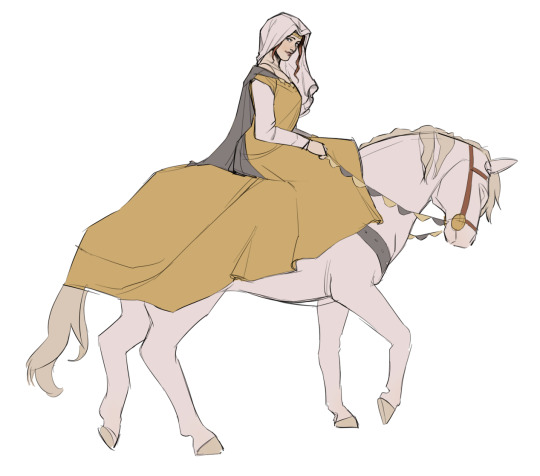
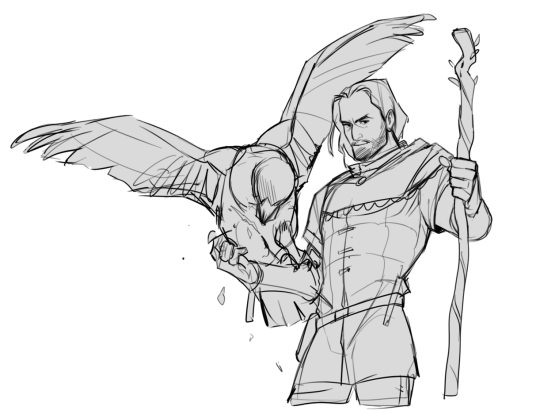
hello tumblr, can our next mass hyperfixation be welsh myths please 🥺
#Y Mabinogi#the mabinogion#Rhiannon#Gwydion fab Dôn#Lleu Llaw Gyffes#welsh mythology#celtic mythology#hmmm i gotta make gwydion look more sneaky#gwydion is a problematic fav of mine lol#magic man pig thief shitty uncle#the eagle is his nephew btw#......................#.......
1K notes
·
View notes
Text

#my art#artists on tumblr#eagle#owl#idk how to tag this tbh#it's re: the mabinogi#lleu llaw gyffes#blodeuwedd#messing around with a messier/lineless style
43 notes
·
View notes
Photo

The Naming of Lleu
#arianrhod#lleu llaw gyffes#mabinogion#welsh mythology#celtic mythology#celtic#mythology#margaret jones
34 notes
·
View notes
Text
Round 1 poll 12: Lleu Llaw Gyffes from Welsh mythology vs The Penitent One from Blasphemous


Propaganda under the cut:
Lleu Llaw Gyffes:
His name is “the blonde guy with good aim” in old Welsh. Like that isn’t the meaning of his name, his name is LITERALLY “Blonde Guy With Good Aim” because he and his morally dubious wizard surrogate father had to trick his absent mother into giving him a name and that was the best he could get away with. He had a wife literally created out of flowers specifically to be his wife and he was such a cold neglectful husband that she cheated on him and then murdered him with the help of her lover. He is invulnerable UNLESS he is: pierced with a lance that was crafted only on Sundays over the span of a year AND it’s thrown at him whilst he’s straddling a river with one foot on the back of a goat. And he STILL doesn’t manage to avoid getting killed because his wife goes “Lleu I’m so worried about you :(((( won’t you show me the very specific manner in which someone could murder you…to ease my mind” and he didn’t find this suspicious at all so immediately demonstrated it to her and then was surprised when her lover pops out and chucks the lance at him. He doesn’t die but instead turns into a hawk which iirc is NEVER EXPLAINED. Then when his wizard turns him back into a human he hunts down his wife’s lover and manages to kill him by throwing a lance THROUGH THE SOLID ROCK the lover is hiding behind. Obsessed with him. Obsessed with the way he undoes everything good in his life by fixating on undoing the damage his mother did to him. I am such a Lleu apologist even though no-one is arguing against me.
The Penitent One:
Blasphemous is a somewhat obscure indie soulslike game which takes place in a fantasy version of 13th century Spain, posing a world where the miracles and fantastical images of catholic mythology and art are literal and happen to everybody constantly. Dedication to the holy forces that rule the land grants power, while sinning against them can physically disfigure or kill someone- the arbitrary rules surrounding virtue and sin in the collective consciousness from which these holy forces stem make this a chaotic and even apocalyptic setting. The gory visuals, difficult gameplay, and dense 13th century language make this a difficult to make into a fandom kind of game. I think there’s like one or two other people on tumblr that I’ve seen that are obsessed with it to the same degree? Anyway, the main character, The Penitent One, is a monk whose whole order has been excommunicated and subsequently executed by the church for their possession of a forbidden artifact. As he makes his way through his pilgrimage to the archcathedral to throw hands with the pope and also god itself if possible, he treats people with compassion, lays the bones of travelers far from home to rest, and violently executes the denizens of the holy miracle who have become literally larger than life in their zealous worship of an unjust god. In doing so, his guilt over the execution of his order transmutes into something holy in and of itself, and he begins to take on the guilt of others until he is a martyr powerful enough to rival the holy miracle. I care so much about his story and the world he occupies! Also he has a silly pointy hat <3
26 notes
·
View notes
Text
Mitologia - País de Gales
A maior fonte de informação sobre a mitologia do País de Gales vem do livro Mabinogion, que alguns estudiosos acreditam ser fragmentos da mitologia celta galesa, em especial as primeiras histórias, conhecidas como Os Quatro Ramos do Mabinogion.

Primeiro Ramo:
Arawn: Arawn (Araun) é o rei do outro mundo na mitologia galesa (Annwn). Ele é um grande caçador e mágico habilidoso em mudar de forma.
Pwyll: Pwyll (Púil) é o rei de Dyfed, marido de Rhiannon e pai de Pryderi. Seu nome quer dizer "bom senso".
Rhiannon: Rhiannon é uma mulher do Outro Mundo, inteligente, bela e famosa por sua generosidade. Com Pwyll ela tem um filho, Pryderi e como viúva ela se casa com Manawydan. Rhiannon significa "grande rainha" e ela é considerada uma deusa da soberania, autoconfiança e resiliência. Como uma figura importante, ela aparece no Primeiro e no Terceiro Ramos.
Pryderi: Pryderi (Pridéri) é filho de Pwyll e da deusa Rhiannon. Ele é o único herói a aparecer em todos os quatro Ramos. Seu nome significa "cuidado, preocupação".

Segundo Ramo:
Branwen: Branwen é casada com o rei da Irlanda, Matholwch e algumas pessoas acreditam que ela seja uma deusa do amor e da beleza. Seu nome significa "corvo branco".
Bendigeidfran: Bendigeidfran (Bendigueidvran) é o gigante rei da Grã-Bretanha e irmão de Brânwen e Manawydan. Seu nome é geralmente traduzido como "corvo abençoado". Quando estava morrendo, Bendigeidfran ordenou que seus seguidores cortassem sua cabeça e a enterrassem sob onde hoje fica a Torre de Londres como um talismã para proteger a Grã-Bretanha de invasões estrangeiras. Hoje em dia, na Torre de Londres, há um grupo de corvos cativos que se acredita protegerem a Coroa e a Torre.
Manawydan: Manawydan (Manauídan) é irmão de Branwen e Bendigeidfran. Ele é associado com o deus dos mares irlandês Manannán mac Lir. As aparições mais importantes de Manawydan ocorrem no Segundo e Terceiro Ramos do Mabinogion.

Quarto Ramo:
Arianrhod: Arianrhod (Arianród) é a deusa do cosmos e do destino. Seu nome significa "roda de prata", simbolizando a lua e/ou a roda que tece o destino. No Mabinogion, ela é mãe de Lleu Llaw Gyffes. Na mitologia galesa, a constelação Corona Borealis é chamada de Caer Arianrhod (o Castelo de Arianrhod).
Lleu Llaw Gyffes: Lleu Llaw Gyffes (Lei Lau Guifes) é filho de Arianrhod. Ele foi negado de um nome, armas e uma esposa, mas seu tio Gwydion forneceu-lhe tudo com truques. Seu nome quer dizer “o de cabelos claros com mãos habilidosas” e ele é visto como o equivalente do deus irlandês Lugh.
Blodeuwedd: Blodeuwedd (Blodêiued) é a esposa de Lleu Llaw Gyffes, feita de flores pelos mágicos Math e Gwydion e que se transforma em uma coruja no final do conto. Seu nome significa "rosto de flor" e ela é considerada deusa da beleza, inteligência e independência.

Outras Histórias:
Ceridwen: Ceridwen (Queríduen) é uma feiticeira que aparece na versão mítica da vida do verdadeiro bardo Taliesin. Ela é considerada uma deusa da inspiração, da memória e do tempo.
Awen: Awen (Auen) é uma palavra galesa que quer dizer "inspiração". É junção da inspiração divina com a imaginação, é o que faz o ser humano compreender o significado e a profundidade das coisas. Awen é a poção que Ceridwen prepara em seu caldeirão cuja apenas as três primeiras gotas concedem conhecimento infinito.
Annwn: Annwn, (Anúven) é o Outro Mundo na mitologia galesa. Governado por Arawn, é um mundo adjacente ao nosso; entre os dois mundos não existem fronteiras, apenas a consciência de uma nova dimensão. Annwn é um mundo sem doenças e com comida sempre abundante.
#celtas#mitologia#mitologia galesa#mabinogion#mitologia celta#arawn#pwyll#rhiannon#pryderi#branwen#bendigeidfran#manawydan#arianrhod#lleu llaw gyffes#blodeuwedd#ceridwen#awen#annwn
1 note
·
View note
Photo




The Evermore Grimoire: Celtic Mythology
Blodeuwedd was a goddess of flowers, emotions and Spring in Celtic mythology who also was literally created from flowers by two magicians. She was made of oak, broom and meadowsweet and her name translates to ‘Flower-Face.’ Blodeuwedd was made specifically to be the wife of the Lleu Llaw Gyffes who had been cursed by his own mother Arianrhod (goddess of the sky). He instantly fell in love with her, and on the day of their marriage the curse was lifted and he was able to take his rightful kingship. Sadly though, Blodeuwedd was not in love with him and instead she fell in love with a handsome hunter named Gronw Pebyr. As time went on, Blodeuwedd knew Gronw was the man she was meant to be with, and so the two of them decided that in order to be free they would have to kill her husband. However one of the magicians was also her Lleu’s uncle who had placed a protection spell on his nephew. One that only Lleu knew about. However because Lleu was so in love Blodeuwedd he told her everything about the spell even though the method of his death was a riddle in itself: “He could not be killed indoors or out, on horse or foot. The only weapon that could kill him would be a spear that took a year to make and could only kill him during a sacred time.” Over time Blodeuwedd was able to trick her husband into a demonstration of his protection spell which allowed her lover Gronw to pierce him with a spear, which turned Lleu in to an eagle, allowing him to fly away to safety. As punishment for her betrayal, she was transformed into an owl. Blodeuwedd has forever remained in this form, mourning the loss of love and reminding people of two important lessons: relationships are fragile, and that beauty isn’t just skin deep.
artwork by TerraIncantata
664 notes
·
View notes
Note
Hello!
Would you happen to know where the idea of not giving your true name to fae originated? I've seen it many places, but I can't quite nail down an origin on it.
Hope you're doing well, thank you so much!
Hi! The short answer is, no I don't. The long answer is mostly me speculating, but I'll do my best:
As far as I can tell the concept that fae will "steal" your name if you "give" it to them is a modern one. It's funny, it's unexpected and a fun play on the "be careful who you give your full name to". But I've never seen it in folklore or fairy tales. What does show up in folktales is fae making people forget their names when they steal them away to fairyland. It doesn't always happen, but sometimes they forget their name, who they are, and where they belong, until they are released.
The idea that names hold power is very old, probably as old as names themselves. As far back as the Mabinogion naming or not naming a child (Lleu Llaw Gyffes) or creation (Blodeuwedd) is very significant. In various Catholic traditions it was important to have someone's full name to be able to pray for them. But that importance can also be negative. In the Odyssey the cyclops cannot curse Odysseus until he knows his name.
The concept that knowing someone's full, true name is significant and potentially dangerous is very present in Western folklore. But it's usually more like "general folk wisdom" than a plot in a story that gets explained. It's closely linked to concepts of bad spirits and evil witchcraft. I think it's more likely that the fae got lumped in with them, than that they had a particular focus on names in their own right.
A good example of the power of knowing names in fairy tales is actually the other way round. The rumpelstiltskin type. Once the human knows the name of this being, they can no longer be harmed by them. There are a lot of variations on this theme, you can find some in the online collection The Name of the Helper by D. L. Ashliman.
So, if I had to give an educated guess. I'd say guarding your name against the fae is no different from guarding it against trolls, witches, or anyone else who might meddle in human affairs.
#hope this was helpful!#it's been a while since there was a folklore question they are always fun ^^#purplecowboypoetry#fae#faeries#folklore#fairy#fairies#laura babbles
78 notes
·
View notes
Text
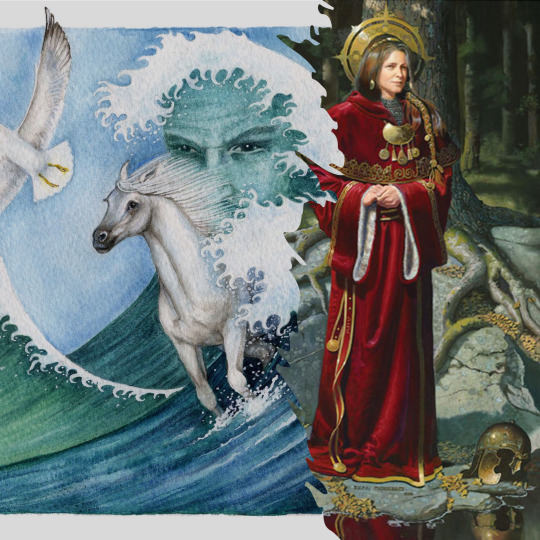
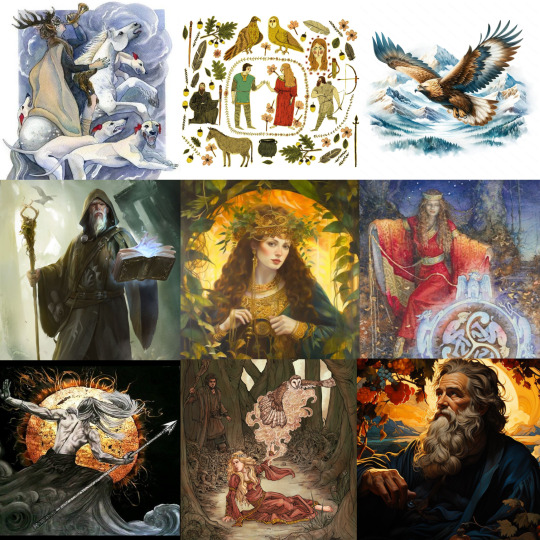

The Houses of the Mabinogi
The Houses of Dôn and Llyr are connected by marriage through Llyr's wife, Penarddun but are diverse in their stories and personalities.
Dôn collage to the bottom left, Llyr collage to the bottom right.
The House of Dôn, apart from the mother goddess herself, boasts two powerful magicians: Math and Gwydion. Also the Goddess of the Wheel of the Year, Arianhod, and her estranged son Lleu Llaw Gyffes are popular characters of this house. The children of Dôn also include Amaethon, the god of agriculture and who started the 'Cad Goddeu' or Battle of the Trees, where all the children declared war against Arawn, King of Annwn. They only won due to Gwydion's expert wizardy with his summoning of a tree army. Finally, the grandson of Dôn, Gwyn, son of Nudd, is popular in Welsh folklore as the king of the Tylwyth Teg (fairy-folk) and leader of the Wild Hunt.
The House of Llyr is smaller in sized but full of tragedy.
Llyr has two sons and one daughter, Branwen. She gets betrothed to the King of Ireland, Matholwch. On return to ireland though, she gets forced into the kitchens. After hearing of his sisters plight, Bran the Blessed, a giant and the King of Britain, wades across the Irish Sea with an army of Welshmen, including his brother and trusted advisor Manawydan. After the tragic death of Branwen's son Gwern, the Welsh and Irish fight until no-one is left but Bran, Branwen, Manawydan and six Welshmen. Unfortunately, Bran finds a poison arrow in his leg and as he is dying, asks Manawydan to cut off his head and take it back to Wales. Upon their return, Branwen dies of a broken heart from her brother and sons death.
#cadno#celtic paganism#wales#welsh pagan#welsh witch#witchcraft#celtic magic#celtic witch#mabinogi#mythology and folklore#celtic mythology#welsh history#history#paganism#pagan#deity work#deity worship#witchblr#witches#witch community
12 notes
·
View notes
Text
Catching up on the @camlannpod stream and I got to the what would your Camlannsona be and I realised I would probably end up as Lleu Llaw Gyffes with my name. Better practice with my spear before the Talepocalypse.
Also, woman with birds? Ceridwen? Morrighan? Some other bird-witch? If it was Blodeuwedd you'd think it would be specifically owls.
15 notes
·
View notes
Note
I think Blodeuwedd – from The Mabinogi – could kill Macbeth. She was made out of flowers by the magicians Math and Gwydion to be Lleu Llaw Gyffes’ wife. Since she was made out of oak, broom and meadowsweet, I think technically, she could also be counted as the woods moving.
It’s possible that Lleu Llaw Gyffes could also kill Macbeth. His mother was asked to take a virginity test so she stepped over a magic rod. Lleu Llaw Gyffes instantly fell out of her as a blob-like entity that only turned human shaped after being locked in a wooden chest for a while.
Yes, Blodeuwedd from Welsh Mythology could kill Macbeth!
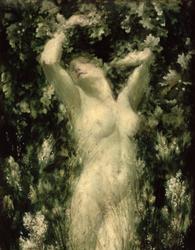
As stated above, she is the goddess of flowers who was crafted out of three kinds of plants by two male magicians, Math and Gwydion, meaning she applies for all three Clauses!
Thank you for your submission!
#asks#unconventional birth clause#gender clause#birth parent clause#blodeuwedd#welsh mythology#celtic mythology#mythology#artistic nudity
41 notes
·
View notes
Photo

Legends and myths about trees
Celtic beliefs in trees (12)
O for Onn (Golden Gorse) - March 21st Spring Equinox
“The Signs of Hope - March equinox of the Celtic tree calendar (Ref)”
Colour: yellow; Star: sun; Gemstone: topaz; Gender: female; Patron: Lugh (Lug), Lleu Llaw Gyffes; Symbol: hope + optimism, unity of power
Golden gorse is an evergreen shrub that takes root almost anywhere in grassy meadows in Britain and western Europe, growing in clumps, with sharp spines on its twigs and smaller spines on its leaves. Strong enough to survive in harsh, cold lands even when strong winds blow, golden gorse bushes provide excellent wind shelter and valuable shelter in bare wastelands.
The thorny leaves prevent the evaporation of water, and the golden flowers bloom at any time, whether sizzling in the sun or covered by sea water. On a calm day with no wind, the flowers have a sweet scent similar to that of coconut or vanilla, and in brilliant sunshine, the pods of the golden gorse burst into tiny seeds that scatter all around, interrupting the buzzing of the bees. The bright golden colour of the flowers uplifts the spirits and beckons the bees in search of sweet nectar.
The ancient Celts would have been looking forward to the arrival of spring, when the golden gorse would be in full bloom and the golden waves would cover the whole area. The yellow flowers of the golden gorse represent the energy of the sun and are symbolic of Lugh, the Celtic sun god of light and talent. The bees also symbolise the wisdom that bees have acquired through their dedicated work. With its evergreen foliage that never ceases to flower all year round, the tree is vital in its radiance and its energy is uninterrupted even during the darkest days of midwinter.
The golden gorse is a sign of courage and a promise of the coming of spring. It is a feast for the eyes and a renewed spark of hope in the midst of disappointment. For the Celts, the golden gorse was a symbol of optimism and trust.

木にまつわる伝説・神話
ケルト人の樹木の信仰 (12)
OはOnn (ハリエニシダ) - 3月21日・春分の日
『希望のしるし 〜 ケルトの木の暦(参照)の春分』
色: 黄色; 星: 太陽; 宝石: トパーズ; 性: 女性; 守護神: 太陽神ルグ、スェウ・スァウ、ゲフェス;シンボル: 希望+楽観、力の結束
ハリエニシダは、英国や西ヨーロッパなら草深い牧草地のほとんどどこにでも根を張る常緑の灌木(かんぼく)で群生し、その小枝に鋭い棘をもち、葉にはもっと小さな棘がある。強風が吹き荒れても厳しい寒さの土地でも生きられるような強さをそなえ、ハリエニシダの茂みは素晴らしい風よけになり、むき出しの荒地では貴重な避難場所を提供してくれる。
棘のある葉は水分の蒸発を防ぎ、太陽にジリジリ焼かれようと、海水をかぶろうと、いつでも黄金色に輝く花を咲かせる。風も絶えて穏やかな日には、ココナッツかヴァニラに似た甘い香りが花にたちこめ、燦々と降りそそぐ日差しのもと、ハリエニシダのさやからは、ミツ��チの羽音を遮るようにポンと種子がはじけて、微小な種子があたり一面に撒き散らされる。目に鮮やかな黄金色の花は気分を昂揚させ、甘い蜜を求めるミツバチたちを招く。
ケルト人たちは、満開に花を咲かせたハリエニシダが黄金色の波となり一面を染め上げる春の到来を心待ちにしていた事だろう。ハリエニシダの黄色い花は太陽のエネルギーを表し、光と才能をつかさどるケルトの太陽神ルグの象徴だ。ミツバチは蜂が献身的に働いて手に入れた知恵も象徴している。一年中花を絶やすことなく、常緑の葉���持つこの樹木は輝きの中に生命力を宿し、そのエネルギーは真冬の暗い日々の間にも途切れることはありません。
ハリエニシダは勇気のしるし、春の訪れの約束です。目を楽しませ、失意のうちにあるものに、ふたたび希望の火を点じる。ケルト人にとって、ハリエニシダは楽観主義と信頼の象徴であった。
#trees#tree legend#tree myth#celtic belief#celtic tree calendar#spring#spring equinox#march equinox#golden gorse#optimism#hope#lugh#bees
98 notes
·
View notes
Text
I’ve had a few messages asking me to elaborate on my comic and I gotta say, I’m super honoured that people are enjoying my silly little drawings and want to know more!!
In short, Gwyn, Edern and Blodeuwedd are figures from medieval Welsh literature and folklore. I just think they’re neat 😌🌸
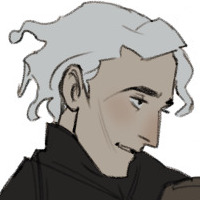
Gwyn
Warrior, Arthurian knight, fairy king and supernatural huntsman, Gwyn is associated with lonely places, like moorlands and mountaintops. He’s evasive, untrustworthy and, especially in earlier texts, has a pretty bad temper. In Culhwch and Olwen, he abducts the object of his affection, Creiddylad, right before her marriage. When her fiancé raises an army against him, Gwyn goes off the deep end a bit, raining violence down on his opponents and taking a bunch of them prisoner. He even tortures one guy into insanity by forcing the guy to eat his own dad's heart. Gwyn’s really caught the imagination of writers throughout time, and at least he seems to have chilled out somewhat over the centuries. For some reason, I like imagining him as tired and sort of past it as a mischief-maker.

Edern/Yder/Ider
Edern is a spirited, confident youth and, like his brother, is a knight of King Arthur. He’s slightly better at it, though. Less violence, more chivalry. Apparently a bit of a hunk too since, in the Romance of Yder, Guinevere admits that Edern would be her first choice if she ever remarried (and it seems Edern was Guinevere’s lover in some traditions). He’s also impatient and cocky, frequently rushing ahead into danger, which normally ends badly for him. In Geraint and Enid, he appears as the ill-mannered Knight of the Sparrowhawk. Despite boasting the title of jousting champion for two years running, he ends up getting beaten badly by Geraint and, begging for mercy, is forced to admit that he’s behaving like a little shit. I like imagining him as a dumbass younger brother.

Blodeuwedd
Blodeuwedd is an owl now, but she used to be a woman. When Lleu Llaw Gyffes was cursed to never have a human wife, his meddling uncle Gwydion magicked him one out of flowers. This flower lady was named Blodeuwedd. When she had an affair and, with her lover, tried to kill Lleu, Gwydion punished her by turning her into an owl, a creature reviled by humans and birds alike. But Blodeuwedd never asked to be a woman and she never asked to be an owl; I think it’s impossible not to feel compassion for her. There’s no real connection between her and Gwyn, but I enjoy imagining them as weird friends. After all, Gwyn’s pretty disliked and feared too.

A (Very, Very Short) Reading List
Here are some links if you want to learn more!
Firstly, I recommend reading Sioned Davies’ translation of The Mabinogion, which is a collection of eleven medieval Welsh stories.
The Mabinogion translated by Sioned Davies (2007)
But there are some free translations online too:
The Mabinogion translated by Charlotte Guest (1877)
In particular, these are the stories I mentioned above:
Culhwch and Olwen
Geraint son of Erbin
Math son of Mathonwy
And here's one of my favourites (not from the Mabinogion): the story of St Collen and Gwyn ap Nudd.
Thanks for reading!!
#the mabinogion#gwyn ap nudd#edern ap nudd#blodeuwedd#arthuriana#culhwch ac olwen#welsh mythology#celtic mythology#y mabinogi#the romance of yder#medieval literature#artists on tumblr#i hope that answered some questions!!#art tag#my ask box is open and ready for your questions and comments about gwyn ap nudd.... please.... 🥺
144 notes
·
View notes
Text
Honestly the welsh language is gorgeous. Just the names of its legends are poetry. Taliesin, Lleu Llaw Gyffes, Blodeuwedd. Saying them out loud is like tasting candy
14 notes
·
View notes
Photo

Math, son of Mathonwy by Margaret Jones
#mabinogion#books#blodeuwedd#lleu llaw gyffes#arianrhod#margaret jones#mythology#celtic#celtic mythology#welsh mythology
31 notes
·
View notes
Text
Round 3 Poll 3: PC from from the 2000s Get a Mac commercials vs Lleu Llaw Gyffes from Welsh mythology


Propaganda:
PC:
He’s basically just a personification of a Windows PC, like he refers to himself as a computer and acts like a computer but he’s really Just Some Guy. And he’s from a series of tv commercials that don’t air anymore so literally no one talks about him but me. But he’s so squinkly binkly and i wanna waggle him around like a mii :] I also kinda kin him lol
Lleu Llaw Gyffes:
His name is “the blonde guy with good aim” in old Welsh. Like that isn’t the meaning of his name, his name is LITERALLY “Blonde Guy With Good Aim” because he and his morally dubious wizard surrogate father had to trick his absent mother into giving him a name and that was the best he could get away with. He had a wife literally created out of flowers specifically to be his wife and he was such a cold neglectful husband that she cheated on him and then murdered him with the help of her lover. He is invulnerable UNLESS he is: pierced with a lance that was crafted only on Sundays over the span of a year AND it’s thrown at him whilst he’s straddling a river with one foot on the back of a goat. And he STILL doesn’t manage to avoid getting killed because his wife goes “Lleu I’m so worried about you :(((( won’t you show me the very specific manner in which someone could murder you…to ease my mind” and he didn’t find this suspicious at all so immediately demonstrated it to her and then was surprised when her lover pops out and chucks the lance at him. He doesn’t die but instead turns into a hawk which iirc is NEVER EXPLAINED. Then when his wizard turns him back into a human he hunts down his wife’s lover and manages to kill him by throwing a lance THROUGH THE SOLID ROCK the lover is hiding behind. Obsessed with him. Obsessed with the way he undoes everything good in his life by fixating on undoing the damage his mother did to him. I am such a Lleu apologist even though no-one is arguing against me.
7 notes
·
View notes
Note
You....you know how Lleu is named after Lleu Llaw Gyffes?.....
Llaw's two uncles canonically had kids together, I already told one of my friends and I am very willing to spread that info more because it is ASTONISHING how Medlleu managed to avoid going down THAT route
I just looked it up and it's insane!!! Morguase would turn them into animals too!
Also, the fact that the reason they are turned into animals in the first place is because they rape their cousin whose name is Goewin! Like those kids were set up to fail. God I need to finish reading the Mabinogion and then reread!
3 notes
·
View notes